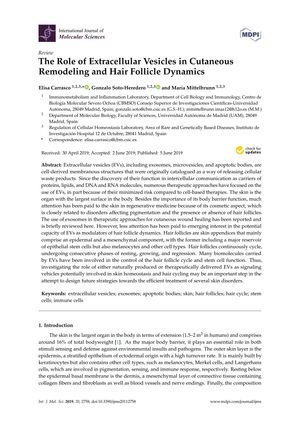The Role of Extracellular Vesicles in Cutaneous Remodeling and Hair Follicle Dynamics
June 2019
in “
International Journal of Molecular Sciences
”
extracellular vesicles EVs exosomes hair follicle dynamics skin regeneration hair cycle stem cell function skin wound healing cell proliferation cell migration angiogenesis collagen deposition pigmentation Wnt factors microRNAs miRNAs alopecia immune cells TGF-β1 FGF-9 immunomodulation wound repair hair growth stem cells wound healing cell growth cell movement blood vessel formation collagen skin color Wnt proteins hair loss TGF-beta immune response

TLDR Tiny particles called extracellular vesicles could help with skin healing and hair growth, but more research is needed.
The document from June 5, 2019, reviews the role of extracellular vesicles (EVs), including exosomes, in skin regeneration, hair follicle dynamics, and their potential therapeutic applications. EVs are highlighted for their ability to carry biomolecules that influence hair cycle and stem cell function, and their involvement in skin wound healing processes such as cell proliferation, migration, angiogenesis, and collagen deposition. The document suggests that EVs, particularly exosomes, can modulate pigmentation and hair follicle function, with exosome-secreted Wnt factors and microRNAs (miRNAs) being potential targets for alopecia treatment. It also discusses the interaction between EVs and immune cells, with molecules like TGF-β1 and FGF-9 playing roles in immunomodulation and wound repair. Several studies are mentioned that demonstrate the potential of EVs to stimulate hair growth and improve wound healing. The document concludes that while EVs show promise as delivery vehicles for skin and hair regeneration, further research is needed to understand their physiological contributions and to standardize methods for their isolation and administration.














